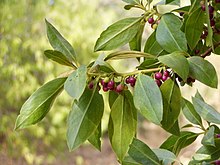Myoporum laetum, commonly known as ngaio (/ˈnaɪoʊ/ NY-oh,[2] Māori: [ˈŋaio]) or mousehole tree, is a species of flowering plant in the family Scrophulariaceae and is endemic to New Zealand. It is a fast growing shrub or small tree with lance-shaped leaves, the edges with small serrations, and white flowers with small purple spots and 4 stamens.
| Myoporum laetum | |
|---|---|

| |
| Leaves and fruit | |
| Scientific classification | |
| Kingdom: | Plantae |
| Clade: | Tracheophytes |
| Clade: | Angiosperms |
| Clade: | Eudicots |
| Clade: | Asterids |
| Order: | Lamiales |
| Family: | Scrophulariaceae |
| Genus: | Myoporum |
| Species: | M. laetum
|
| Binomial name | |
| Myoporum laetum | |
| Synonyms[1] | |
Description
editNgaio is a fast-growing evergreen shrub or small tree that sometimes grows to a height of 10 metres (30 ft) with a trunk up to 0.3 metres (1 ft) in diameter, or spreads to as much as 4 metres (10 ft). It often appears dome-shaped at first but as it gets older, distorts as branches break off. The bark on older specimens is thick, corky and furrowed. The leaves are lance-shaped, usually 52–125 millimetres (2–5 in) long, 15–30 millimetres (0.6–1 in) wide, have many translucent dots in the leaves and edges that have small serrations in approximately the outer half.[3][4][5]
The flowers are white with purple spots and are borne in groups of 2 to 6 on stalks 7–15 millimetres (0.3–0.6 in) long. There are 5 egg-shaped, pointed sepals and 5 petals joined at their bases to form a bell-shaped tube 3.5–4.5 millimetres (0.1–0.2 in) long. The petal lobes are 4.5–5.5 millimetres (0.18–0.22 in) long making the flower diameter 15–20 millimetres (0.6–0.8 in). There are four stamens that extend slightly beyond the petal tube and the ovary is superior with 2 locules. Flowering occurs from mid-spring to mid-summer and is followed by the fruit which is a bright red drupe 6–9 millimetres (0.2–0.4 in) long.[3][4][5]
Taxonomy and naming
editMyoporum laetum was first formally described in 1786 by Georg Forster in Florulae Insularum Australium Prodromus.[1][6] The specific epithet (laetum) means "cheerful, pleasant or bright".[7]
Distribution and habitat
editNgaio grows very well in coastal areas of New Zealand including the Chatham Islands. It grows in lowland forest, sometimes in pure stands, others in association with other species such as nikau (Rhopalostylis sapida).[3]
Ecology
editMyoporum laetum has been introduced to several other countries including Portugal, South Africa and Namibia.[3] It is considered an invasive exotic species by the California Exotic Pest Plant Council.[8]
Uses
editIndigenous use
editThe Māori would rub the leaves over their skin to repel mosquitoes and sandflies.[9]
Horticulture
editNgaio is a hardy plant that will grow in most soils but needs full sun. It can also tolerate exposure to salt spray.[10] It can be grown from seed or from semi-hard cuttings.[4]
Toxicity
editThe leaves of this tree contain the liver toxin ngaione, which can cause sickness and or death in stock such as horses, cattle, sheep and pigs.[11]
Māori legend
editAccording to Māori legend,[12] a Ngaio tree can be seen on the Moon. Here is the story, as recounted by politician, historian, poet William Pember Reeves (1857–1932):
The man in the moon becomes, in Māori legend, a woman, one Rona by name. This lady, it seems, once had occasion to go by night for water to a stream. In her hand she carried an empty calabash. Stumbling in the dark over stones and the roots of trees she hurt her shoeless feet and began to abuse the moon, then hidden behind clouds, hurling at it some such epithet as "You old tattooed face, there!" But the moon-goddess heard, and reaching down caught up the insulting Rona, calabash and all, into the sky. In vain the frightened woman clutched, as she rose, the tops of a ngaio-tree. The roots gave way, and Rona with her calabash and her tree are placed in the front of the moon for ever, an awful warning to all who are tempted to mock at divinities in their haste.[13]
See also
editReferences
edit- ^ a b c "Myoporum laetum". Plants of the World Online. Retrieved 22 November 2022.
- ^ Wells, John C. (1982). Accents of English. Vol. 3: Beyond the British Isles (pp. i–xx, 467–674). Cambridge University Press. p. 610. doi:10.1017/CBO9780511611766. ISBN 0-52128541-0.
- ^ a b c d Chinnock, R.J. (Bob) (2007). Eremophila and allied genera : a monograph of the plant family Myoporaceae (1st ed.). Dural, NSW: Rosenberg. pp. 115–117. ISBN 9781877058165.
- ^ a b c "Myoporum laetum". New Zealand Plant Conservation Network. Retrieved 1 December 2015.
- ^ a b Dawson, John; Lucas, Rob (2000). Nature guide to the New Zealand forest (2007 ed.). Auckland, N.Z.: Godwit. p. 116. ISBN 1869620550.
- ^ Forster, Georg (1786). Florulae insularum Australium :prodromus. Gottingae. p. 44. Retrieved 22 November 2022.
- ^ William T. Stearn (1992). Botanical Latin. History, grammar, syntax, terminology and vocabulary (4th ed.). Portland, Oregon: Timber Press. p. 438.
- ^ "Myoporum laetum". California Invasive Plant Council. Retrieved 1 December 2015.
- ^ "Story: Sandflies and mosquitoes". Teara: The Encyclopedia of New Zealand. Retrieved 1 December 2015.
- ^ "Myoporum laetum". Plants for a Future. Retrieved 1 December 2015.
- ^ Encyclopaedia of Clinical Toxicology: A Comprehensive Guide and Reference, by Irving S. Rossoff
- ^ "Stories Of Old - Rona and the Moon". Maori.org.
- ^ "The Long White Cloud, by William Pember Reeves". The Project Gutenberg eBook. Retrieved 1 December 2015.